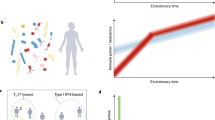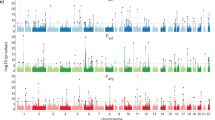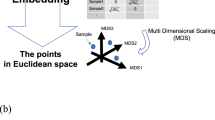Abstract
By developing a high-density murine immunophenotyping platform compatible with high-throughput genetic screening, we have established profound contributions of genetics and structure to immune variation (http://www.immunophenotype.org). Specifically, high-throughput phenotyping of 530 unique mouse gene knockouts identified 140 monogenic ‘hits’, of which most had no previous immunologic association. Furthermore, hits were collectively enriched in genes for which humans show poor tolerance to loss of function. The immunophenotyping platform also exposed dense correlation networks linking immune parameters with each other and with specific physiologic traits. Such linkages limit freedom of movement for individual immune parameters, thereby imposing genetically regulated ‘immunologic structures’, the integrity of which was associated with immunocompetence. Hence, we provide an expanded genetic resource and structural perspective for understanding and monitoring immune variation in health and disease.
This is a preview of subscription content, access via your institution
Access options
Access Nature and 54 other Nature Portfolio journals
Get Nature+, our best-value online-access subscription
$29.99 / 30 days
cancel any time
Subscribe to this journal
Receive 12 print issues and online access
$209.00 per year
only $17.42 per issue
Buy this article
- Purchase on Springer Link
- Instant access to full article PDF
Prices may be subject to local taxes which are calculated during checkout








Similar content being viewed by others
Data availability
The flow cytometry files that support the findings of this study are available from http://www.flowrepository.org with the following identifiers: 3i PBMC panel 1, FR-FCM-ZYPJ; 3i PBMC panel 2, FR-FCM-ZYPK; 3i T-cell Spleen IMPC, FR-FCM-ZYX9; 3i T-cell MLN IMPC, FR-FCM-ZYXB; 3i B-cell Spleen IMPC, FR-FCM-ZYXC; 3i B-cell MLN IMPC, FR-FCM-ZYXE; 3i M-cell Spleen IMPC, FR-FCM-ZYXF; 3i M-cell MLN IMPC, FR-FCM-ZYXG; 3i P2 SPL IMPC, FR-FCM-ZYXN; 3i BM IMPC, FR-FCM-ZYXQ. Vignettes showing gating of affected cell populations in KO mice and controls are available for all phenotypes deemed important in the present study in flow cytometry assays through https://www.mousephenotype.org (access through Associated Images on a gene page). Microscopy image files from ear epidermis assay, ANA assay and DSS histology are available from the corresponding author upon request and have been submitted to https://www.mousephenotype.org (access through Associated Images on a gene page). All assay results on mouse and strain level that support the findings of the present study are available through http://www.immunophenotype.org (website entirely devoted to this project) and https://www.mousephenotype.org (access via gene name). Source data for Figs. 1–3 and 5–8 are presented with the paper. Supporting data are also available from https://github.com/AnnaLorenc/3i_heatmapping. All mouse lines analyzed in this work are available from repositories linked to the IMPC (https://www.mousephenotype.org) or from WSI (email mouseinterest@sanger.ac.uk). Cell lines are available upon request.
Code availability
Code used for initial hit calling and preprocessed per-mouse data for flow cytometry, ear epidermis and DSS assays are available from https://github.com/AnnaLorenc/3i_heatmapping. The PhenStat R package used for influenza analysis is available on Bioconductor (http://www.bioconductor.org)61. The ImageJ macro and the Python code used to score ANA positivity, the Definiens Developer code to assess ear epidermis images and the R code used to assess the FPRs are available upon request.
References
Nakaya, H. I. et al. Systems biology of vaccination for seasonal influenza in humans. Nat. Immunol. 12, 786–795 (2011).
Sobolev, O. et al. Adjuvanted influenza-H1N1 vaccination reveals lymphoid signatures of age-dependent early responses and of clinical adverse events. Nat. Immunol. 17, 204–213 (2016).
Tsang, J. S. et al. Global analyses of human immune variation reveal baseline predictors of postvaccination responses. Cell 157, 499–513 (2014).
Wei, S. C. et al. Distinct cellular mechanisms underlie anti-CTLA-4 and anti-PD-1 checkpoint blockade. Cell 170, 1120–1133.e17 (2017).
Brodin, P. et al. Variation in the human immune system is largely driven by non-heritable influences. Cell 160, 37–47 (2015).
Carr, E. J. et al. The cellular composition of the human immune system is shaped by age and cohabitation. Nat. Immunol. 17, 461–468 (2016).
Patin, E. et al. Natural variation in the parameters of innate immune cells is preferentially driven by genetic factors. Nat. Immunol. 19, 302–314 (2018).
Alpert, A. et al. A clinically meaningful metric of immune age derived from high-dimensional longitudinal monitoring. Nat. Med. 25, 362–364 (2019).
Ellinghaus, D. et al. Analysis of five chronic inflammatory diseases identifies 27 new associations and highlights disease-specific patterns at shared loci. Nat. Genet. 48, 510–518 (2016).
Liu, J. Z. et al. Association analyses identify 38 susceptibility loci for inflammatory bowel disease and highlight shared genetic risk across populations. Nat. Genet. 47, 979–986 (2015).
Tsoi, L. C. et al. Identification of 15 new psoriasis susceptibility loci highlights the role of innate immunity. Nat. Genet. 44, 1341–1348 (2012).
Orrù, V. et al. Genetic variants regulating immune cell levels in health and disease. Cell 155, 242–256 (2013).
Nelms, K. A. & Goodnow, C. C. Genome-wide ENU mutagenesis to reveal immune regulators. Immunity 15, 409–418 (2001).
Wang, T. et al. Real-time resolution of point mutations that cause phenovariance in mice. Proc. Natl Acad. Sci. USA 112, E440–E449 (2015).
Steri, M. et al. Overexpression of the cytokine BAFF and autoimmunity risk. N. Engl. J. Med 376, 1615–1626 (2017).
Zhang, S.-Y. et al. TLR3 deficiency in patients with herpes simplex encephalitis. Science 317, 1522–1527 (2007).
Turnbull, C. et al. The 100 000 genomes project: bringing whole genome sequencing to the NHS. BMJ 361, k1687 (2018).
Zambrowicz, B. P. & Sands, A. T. Knockouts model the 100 best-selling drugs—will they model the next 100? Nat. Rev. Drug Discov. 2, 38–51 (2003).
Skarnes, W. C. et al. A conditional knockout resource for the genome-wide study of mouse gene function. Nature 474, 337–342 (2011).
Saleheen, D. et al. Human knockouts and phenotypic analysis in a cohort with a high rate of consanguinity. Nature 544, 235–239 (2017).
White, J. K. et al. Genome-wide generation and systematic phenotyping of knockout mice reveals new roles for many genes. Cell 154, 452–464 (2013).
Rahim, A. et al. High throughput automated analysis of big flow cytometry data. Methods 134–135, 164–176 (2018).
Cooper, G. S. & Stroehla, B. C. The epidemiology of autoimmune diseases. Autoimmun. Rev. 2, 119–125 (2003).
Ananthakrishnan, A. N. Epidemiology and risk factors for IBD. 12, 205–217 (2015).
Zhou, X. et al. Circuit design features of a stable two-cell system. Cell 172, 744–747.e17 (2018).
Byers, S. L., Wiles, M. V., Dunn, S. L. & Taft, R. A. Mouse estrous cycle identification tool and images. PLoS One 7, e35538 (2012).
Huang, S. C.-C. et al. Metabolic reprogramming mediated by the mTORC2-IRF4 signaling axis is essential for macrophage alternative activation. Immunity 45, 817–830 (2016).
Kolev, M. et al. Complement regulates nutrient influx and metabolic reprogramming during Th1 cell responses. Immunity 42, 1033–1047 (2015).
Salvagno, G. L., Sanchis-Gomar, F., Picanza, A. & Lippi, G. Red blood cell distribution width: a simple parameter with multiple clinical applications. Crit. Rev. Clin. Lab. Sci. 52, 86–105 (2015).
Olumuyiwa-Akeredolu, O. O. & Pretorius, E. Platelet and red blood cell interactions and their role in rheumatoid arthritis. Rheumatol. Int. 35, 1955–1964 (2015).
Pilling, L. C., Atkins, J. L., Kuchel, G. A., Ferrucci, L. & Melzer, D. Red cell distribution width and common disease onsets in 240,477 healthy volunteers followed for up to 9 years. PLoS One 13, e0203504 (2018).
Xuan, C. et al. RBB, a novel transcription repressor, represses the transcription of HDM2 oncogene. Oncogene 32, 3711–3721 (2012).
Barbee, S. D. et al. Skint-1 is a highly specific, unique selecting component for epidermal T cells. Proc. Natl Acad. Sci. USA 108, 3330–3335 (2011).
Narita, T., Nitta, T., Nitta, S., Okamura, T. & Takayanagi, H. Mice lacking all of the Skint family genes. Int. Immunol. 30, 301–309 (2018).
Liu, S. et al. Diphthamide modification on eukaryotic elongation factor 2 is needed to assure fidelity of mRNA translation and mouse development. Proc. Natl Acad. Sci. USA 109, 13817–13822 (2012).
Chen, C.-M. & Behringer, R. R. Ovca1 regulates cell proliferation, embryonic development, and tumorigenesis. Genes Dev. 18, 320–332 (2004).
Liu, S. et al. Dph3, a small protein required for diphthamide biosynthesis, is essential in mouse development. Mol. Cell. Biol. 26, 3835–3841 (2006).
Jackson, R. et al. The translation of non-canonical open reading frames controls mucosal immunity. Nature 564, 434–438 (2018).
Grasberger, H. & Refetoff, S. Identification of the maturation factor for dual oxidase. Evolution of an eukaryotic operon equivalent. J. Biol. Chem. 281, 18269–18272 (2006).
Christodoulou, K. et al. Next generation exome sequencing of paediatric inflammatory bowel disease patients identifies rare and novel variants in candidate genes. Gut 62, 977–984 (2013).
Cooper, J. D. et al. Meta-analysis of genome-wide association study data identifies additional type 1 diabetes risk loci. Nat. Genet. 40, 1399–1401 (2008).
Liu, W. et al. Identification of BACH2 as a susceptibility gene for Graves’ disease in the Chinese Han population based on a three-stage genome-wide association study. Hum. Genet. 133, 661–671 (2014).
Roychoudhuri, R. et al. BACH2 represses effector programs to stabilize Treg-mediated immune homeostasis. Nature 498, 506–510 (2013).
Afzali, B. et al. BACH2 immunodeficiency illustrates an association between super-enhancers and haploinsufficiency. Nat. Immunol. 18, 813–823 (2017).
Lek, M. et al. Analysis of protein-coding genetic variation in 60,706 humans. Nature 536, 285–291 (2016).
Karczewski, K. J. et al. Variation across 141,456 human exomes and genomes reveals the spectrum of loss-of-function intolerance across human protein-coding genes. Preprint at bioRxiv https://dx.doi.org/10.1101/531210 (2019).
Goltsev, Y. et al. Deep profiling of mouse splenic architecture with CODEX multiplexed imaging. Cell 174, 968–981.e15 (2018).
Piasecka, B. et al. Distinctive roles of age, sex, and genetics in shaping transcriptional variation of human immune responses to microbial challenges. Proc. Natl Acad. Sci. USA 115, E488–E497 (2018).
Zalocusky, K. A. et al. The 10,000 immunomes project: building a resource for human immunology. Cell Rep. 25, 513–522.e3 (2018).
Márquez, A. et al. A combined large-scale meta-analysis identifies COG6 as a novel shared risk locus for rheumatoid arthritis and systemic lupus erythematosus. Ann. Rheum. Dis. 76, 286–294 (2017).
Liu, Y. et al. A genome-wide association study of psoriasis and psoriatic arthritis identifies new disease loci. PLoS Genet. 4, e1000041 (2008).
Kuijpers, T. W. et al. Combined immunodeficiency with severe inflammation and allergy caused by ARPC1B deficiency. J. Allergy Clin. Immunol. 140, 273–277.e10 (2017).
Sade-Feldman, M. et al. Defining T cell states associated with response to checkpoint immunotherapy in melanoma. Cell 175, 998–1013.e20 (2018).
Karp, N. A. et al. Applying the ARRIVE guidelines to an in vivo database. PLoS Biol. 13, e1002151 (2015).
Karp, N. A. Robust and sensitive analysis of mouse knockout phenotypes. PLoS One 7, e52410 (2012).
Karp, N. A. et al. Impact of temporal variation on design and analysis of mouse knockout phenotyping studies. PLoS One 9, e111239 (2014).
Ryder, E. et al. Molecular characterization of mutant mouse strains generated from the EUCOMM/KOMP-CSD ES cell resource. Mamm. Genome 24, 286–294 (2013).
Malek, M. et al. flowDensity: reproducing manual gating of flow cytometry data by automated density-based cell population identification. Bioinformatics 31, 606–607 (2015).
Mason, J. et al. Prevalence of sexual dimorphism in mammalian phenotypic traits. Nat. Commun. 8, 15475 (2017).
Mi, H., Muruganujan, A., Ebert, D., Huang, X. & Thomas, P. D. PANTHER version 14: more genomes, a new PANTHER GO-slim and improvements in enrichment analysis tools. Nucleic Acids Res. 47, D419–D426 (2018).
Kurbatova, N., Mason, J. C., Morgan, H., Meehan, T. F. & Karp, N. A. PhenStat: a tool kit for standardized analysis of high throughput phenotypic data. PLoS One 10, e0131274 (2015).
Acknowledgements
We thank many colleagues for advice, particularly: S. Heck of the Biomedical Research Centre of Guy’s and St Thomas’ Hospital and King’s College London; D. Davies of the Francis Crick Institute; F. Geissmann, R. Noelle, J. Strid and O. Sobolev in the early stages of program planning; and N. Karamanis and K. Hawkins for UX testing of the website. The project was funded by a Wellcome Trust grant (no. 100156/Z/12/Z). M.D.-C. received funding from the European Union’s Horizon 2020 research and innovation program under the Marie Sklodowska–Curie grant agreement no. 656347. K.O.B., J.W. and T.M. were supported by the National Institutes of Health (NIH) Common Fund (grant no. UM1 HG006370). The development of automated flow analysis in R.B.’s group was supported by Genome BC (grant no. SOF152), the Natural Sciences and Engineering Research Council of Canada, the International Society for Advancement of Cytometry Genome Canada, Genome BC (grant no. 252FLO), the National Institute of General Medical Sciences (grant no. R01GM118417) and the Canadian Institutes of Health Research. G.D. was supported by a National Institute for Health Research grant to the Cambridge Biomedical Centre. W.J. was supported by an NIH grant (no. AI026170). C.M.L. is supported by a Wellcome Senior Fellowship in Basic Biomedical Science (no. 107059/Z/15/Z). R.J.C. is a principal investigator of the Medical Research Council’s Human Immunology Unit. K.J.M. is funded by a Wellcome Trust Investigator Award (no. 102972/Z/13/Z). R.K.G. holds a Wellcome Trust Investigator Award (no. Z10661/Z/18/Z) and is part of the Wellcome Trust Centre for Cell Matrix Research funded by an award (no. Z03128/Z/16/Z). In addition, the project was supported by grants and facilities provided to A.C.H. by the Francis Crick Institute, which receives its core funding from Cancer Research UK (grant no. FC001093), the UK Medical Research Council (grant no. FC001093) and the Wellcome Trust (grant no. FC001093).
Author information
Authors and Affiliations
Contributions
J.K.W., F.P., G.D., W.J., C.M.L., R.J.C., K.J.M., R.K.G., G.M.G., D.J.A. and A.C.H. conceptualized the present study. L.A.-D., A.G.L., A.L., D.S.U., S. Clare, A.O.S., N. Saran, M.A.D.-C., K.R.B., B.M., J.I. P.R.B., K.I.H., E. Cambridge, S.F., T.L.C., B.W., A.R., S.D., J.M., A.Y., M.L., G.X.S.-Z., A.C., R.B., G.D., W.J., C.M.L., R.J.C., K.J.M., R.K.G., G.M.G., D.J.A. and A.C.H. provided the methodology. A.L., M.G., N.A.K., D.M., A.R., S.D., J.M., A.Y., M.L., J.A. and R.B. provided the software. L.A.-D., A.L., K.O.B., J.W., J.C.M., A.M. and T.F.M. dealt with the website. L.A.-D., A.G.L., A.L., D.S.U., S. Clare, A.O.S., N. Saran, M.A.D.-C., K.R.B., B.M., J.I., P.R.B. and E. Cambridge provided the validation. L.A.-D., A.G.L., A.L., D.S.U., S. Caetano, A.O.S., N. Saran, M.A.D.-C., K.R.B., B.M., J.I., P.R.B., E. Cambridge and A.C.H. did the formal analysis. L.A.-D., A.G.L., D.S.U., S. Clare, A.O.S., M.A.D.-C., N. Saran, K.R.B., B.M., J.I., P.R.B., S. Caetano, K.I.H., E. Cambridge, S.F., T.L.C., L.K., K.H., C.B., G.N., E. Cawthorne, B.W., G.X.S.-Z., A.C., C.B.R., H.W., A.P-K., M.E., N. Strevens and M.P. carried out the investigations. L.A.-D. and A.L. curated the data. A.C.H. wrote the original draft. L.A.-D., A.G.L., A.L., D.S.U., A.O.S., N. Saran, N.A.K., J.A., G.D., R.J.C., R.K.G., D.J.A. and A.C.H. reviewed and edited the manuscript. L.A.-D., A.G.L., A.L. and A.C.H. visualized it. T.F.M., R.B., G.D., W.J., C.M.L., R.J.C., K.J.M., R.K.G., G.M.G., D.J.A. and A.C.H. supervised. L.A.-D., J.K.W., S. Clare, A.O.S., R.R-S. and A.C.H. were the project administrators. R.B., F.P., G.D., W.J., C.M.L., R.J.C., K.J.M., R.K.G., G.M.G., D.J.A. and A.C.H. carried out the funding acquisition.
Corresponding author
Additional information
Peer review information Z. Fehervari was the primary editor on this article, and managed its editorial process and peer review in collaboration with the rest of the editorial team.
Publisher’s note Springer Nature remains neutral with regard to jurisdictional claims in published maps and institutional affiliations.
Supplementary information
Supplementary Information
Supplementary Figs. 1–6 and Tables 1–5.
Source data
Source Data Fig. 1
Statistical source data
Source Data Fig. 2
Statistical source data
Source Data Fig. 3
Statistical source data
Source Data Fig. 5
Statistical source data
Source Data Fig. 6
Statistical source data
Source Data Fig. 7
Statistical source data
Source Data Fig. 8
Statistical source data
Source Data Extended Data Fig. 1
Statistical source data
Source Data Extended Data Fig. 2
Statistical source data
Source Data Extended Data Fig. 3
Statistical source data
Source Data Extended Data Fig. 4
Statistical source data
Source Data Extended Data Fig. 5
Statistical source data
Rights and permissions
About this article
Cite this article
Abeler-Dörner, L., Laing, A.G., Lorenc, A. et al. High-throughput phenotyping reveals expansive genetic and structural underpinnings of immune variation. Nat Immunol 21, 86–100 (2020). https://doi.org/10.1038/s41590-019-0549-0
Received:
Accepted:
Published:
Issue Date:
DOI: https://doi.org/10.1038/s41590-019-0549-0
This article is cited by
-
Normality sensing licenses local T cells for innate-like tissue surveillance
Nature Immunology (2022)
-
NDRG1 is induced by antigen-receptor signaling but dispensable for B and T cell self-tolerance
Communications Biology (2022)
-
Lineage-specific protein repeat expansions and contractions reveal malleable regions of immune genes
Genes & Immunity (2022)
-
“Moonlighting” at the power plant: how mitochondria facilitate serial killing by CD8+ cytotoxic T cells
Signal Transduction and Targeted Therapy (2021)
-
Genetic landscape of T cells identifies synthetic lethality for T-ALL
Communications Biology (2021)



